Preparation of Glass-Ceramic Materials by Controlled Crystallization of Eu2O3-Doped WO3-B2O3-La2O3 Glasses and Their Luminescent Properties
Abstract
1. Introduction
2. Results and Discussion
2.1. XRD Data and DTA Analysis
2.2. Luminescent Properties
2.3. TEM Investigations
3. Materials and Methods
3.1. Samples Preparation
3.2. Samples Characterization
4. Conclusions
Author Contributions
Funding
Institutional Review Board Statement
Informed Consent Statement
Data Availability Statement
Acknowledgments
Conflicts of Interest
References
- Kumar, K.N.; Vijayalakshmi, L.; Lee, G.; Kang, G.; Lim, J.; Choi, J. Robust color purity of reddish-orange emission from Sm3+-activated La10W22O81 biocompatible microphosphors for solid state lighting and anticancer applications. J. Rare Earths 2023, 41, 1850–1859. [Google Scholar] [CrossRef]
- Patout, L.; Jacob, D.; Arab, M.; Pereira de Souza, C.; Leroux, C. Monoclinic Superstructure in Orthorhombic Ce10W22O81 from Transmission Electron Microscopy. Acta Crystallogr. Sect. B Struct. Sci. Cryst. Eng. Mater. 2014, 70, 268–274. [Google Scholar] [CrossRef] [PubMed]
- Pier, T.; Jüstel, T. Application of Eu(III) activated tungstates in solid state lighting. Opt. Mater. 2024, X22, 100299. [Google Scholar] [CrossRef]
- Cheng, Q.; Ren, F.; Lin, Q.; Tong, H.; Miao, H. High quantum efficiency red emitting alpha-phase La2W2O9: Eu3+phosphor. J. Alloys Compd. 2019, 772, 905–911. [Google Scholar] [CrossRef]
- Song, K.; Li, G. Electrospinning synthesis, characterization and luminescence properties of La2W2O9: Eu3+ nanofibers. J. Mater. Sci. Mater. Electron. 2015, 27, 1227–1231. [Google Scholar] [CrossRef]
- Zhang, J.; Yang, Y.; Yu, F.; Liu, Y.; Han, B.; Chao, M.; Liu, L. Synthesis and Luminescence Properties of La2W2O9:Eu3+ Micron-Crystals. J. Nanosci. Nanotechnol. 2016, 16, 3852–3856. [Google Scholar] [CrossRef]
- Baby, B.; Thomas, S.; Jose, J.; Gopinath, M.; Biju, P.R.; Joseph, C. Spectroscopic analysis of La2(WO4)3:Tb3+ phosphor and the delayed concentration quenching of 5D4 →7FJ emission. J. Lumin. 2025, 277, 120895. [Google Scholar] [CrossRef]
- Naveen Kumar, K.; Vijayalakshmi, L.; Hwang, P.; Wadhwani, A.; Choi, J. Bright red-luminescence of Eu3+ion-activated La10W22O8 microphosphors for noncytotoxic latent fingerprint imaging. J. Alloys Compd. 2020, 840, 155589. [Google Scholar] [CrossRef]
- Fedorov, P.P.; Luginina, A.A.A.; Popov, I. Transparent oxyflouride glas ceramics. J. Fluor. Chem. 2015, 172, 22–50. [Google Scholar] [CrossRef]
- Erth, D. Photoluminescenec in Glass and Glass Ceramics. IOP Conf. Ser. Mater. Sci. Eng. 2009, 2, 012001. [Google Scholar]
- Ferrari, M.; Righini, G.C. Glass-ceramic materials for guided-waste optics. Int. J. Appl. Sci. 2015, 6, 240–248. [Google Scholar]
- Aleksandrov, L.; Iordanova, R.; Dimitried, Y.; Geogiev, N.; Komatsu, T. Eu3+ doped 1La2O3:2WO3:1B2O3 glass and glass-ceramic. Opt. Mater. 2014, 26, 1366–1372. [Google Scholar] [CrossRef]
- Aleksandrov, L.; Komatsu, T.; Iordanova, R.; Dimitried, Y. Raman spectroscopic study of structure of WO3-La2O3-B2O3 glasses with no color and crystallization of LaBWO6. Opt. Mater. 2011, 34, 201–206. [Google Scholar] [CrossRef]
- Jurinski, B.; Lisanova, G. Compounds of rare earth elements with mixed oxyanions: Synthesis, structure, boundaries of existence in the series La-Lu. J. Inorg. Chem. 1998, 43, 2064–2074. [Google Scholar]
- Collado, J.A.; Aranda, M.A.G.; Cabeza, A.; Olivera-Pastor, P.; Bruque, S. Synthesis, structures, and thermal expansion of the La2W2− xMoxO9 series. J. Solid State Chem. 2002, 167, 80–85. [Google Scholar] [CrossRef]
- Goutenoire, F.; Isnard, O.; Retoux, R.; Lacorre, P. Crystal Structure of La2Mo2O9, a New Fast Oxide−Ion Conductor. Chem. Mater. 2000, 12, 2575–2580. [Google Scholar] [CrossRef]
- Yoshimura, M.; Rouanet, A. High temperature phase relation in the system La2O3-WO3. Mater. Res. Bull. 1976, 11, 151–158. [Google Scholar] [CrossRef]
- Marrero-López, D.; Peña-Martínez, J.; Ruiz-Morales, J.C.; Núñez, P. Phase stability and ionic conductivity in substituted La2W2O9. J. Solid State Chem. 2008, 181, 253–262. [Google Scholar] [CrossRef]
- Binnemans, K. Interpretation of europium (III) spectra. Coord. Chem. Rev. 2015, 295, 1–45. [Google Scholar] [CrossRef]
- Blasse, G.; Grabmaier, B.C. Luminescent Materials, 1st ed.; Springer: Berlin/Heidelber, Germany, 1994; pp. 18–29. [Google Scholar]
- Hoefdraad, H.E. The charge-transfer absorption band of Eu3+ in oxides. J. Solid State Chem. 1975, 15, 175–177. [Google Scholar] [CrossRef]
- Parchur, A.K.; Ningthoujam, R.S. Behaviour of electric and magnetic dipole transitions of Eu3+, 5D0-7F0 and Eu-O charge transfer band in Li+ co-doped YPO4:Eu3+. RSC Adv. 2012, 2, 10859–10868. [Google Scholar] [CrossRef]
- Mariselvam, K.; Liu, J. Synthesis and luminescence properties of Eu3+ doped potassium titano telluroborate (KTTB) glasses for red laser applications. J. Lumin. 2021, 230, 117735. [Google Scholar] [CrossRef]
- Dutta, P.S.; Khanna, A. Eu3+ activated molybdate and tungstate based red phosphors with charge transfer band in blue region. ECS J. Solid State Sci. Technol. 2013, 2, R3153–R3167. [Google Scholar] [CrossRef]
- Thieme, C.; Herrmann, A.; Kracker, M.; Patzig, C.; Hoche, T.; Russel, C. Microstructure investigation and fluorescence properties of Europium-doped scheelite crystals in glass-ceramics made under different synthesis conditions. J. Lumin. 2021, 238, 118244. [Google Scholar] [CrossRef]
- Bunzli, J.C.G. Lanthanide luminescence: From a mystery to rationalization, understanding, and applications. In Handbook on the Physics and Chemistry of Rare Earths; Elsevier: Amsterdam, The Netherlands, 2016; Volume 50, pp. 141–176. [Google Scholar]
- Fu, J.; Kobayashi, M.; Sigimoto, S.; Parker, J.M. Scintillation from Eu2+ in Nanocrystallized Glass. J. Am. Ceram. Soc. 2009, 92, 2019–2021. [Google Scholar] [CrossRef]
- Shigeo, S.; William, M. Phosphor Handbook; CRC Press: Washington, DC, USA, 1998. [Google Scholar]
- Iordanova, R.; Milanova, M.; Yordanova, A.; Aleksandrov, L.; Nedylkov, N.; Kukeva, R.; Petrova, P. Structure and Luminescent Properties of Niobium Modified ZnO-B2O3: Eu3+ Glass. Materials 2024, 17, 1415. [Google Scholar] [CrossRef]
- Milanova, M.; Aleksandrov, L.; Yordanova, A.; Iordanova, R.; Tagiara, N.S.; Herrmann, A.; Gao, G.; Wondraczek, L.; Kamitsos, E.I. Structural and luminescence behavior of Eu3+ ions in ZnO-B2O3-WO3 glasses. J. Non-Cryst. Solids 2023, 600, 122006. [Google Scholar] [CrossRef]
- Aleksandrov, L.; Milanova, M.; Yordanova, A.; Iordanova, R.; Nedyalkov, N.; Petrova, P.; Tagiara, N.S.; Palles, D.; Kamitsos, E.I. Synthesis, structure and luminescence properties of Eu3+-doped 50ZnO.40B2O3.5WO3.5Nb2O5 glass. Phys. Chem. Glas. Eur. J. Glass Sci. Technol. B 2023, 64, 101–109. [Google Scholar]
- Narro-García, R.; Desirena, H.; López-Luke, T.; Guerrero-Contreras, J.; Jayasankar, C.K.; Quintero-Torres, R.; De la Rosa, E. Spectroscopic properties of Eu3+/Nd3+ co-doped phosphate glasses and opaque glass–ceramics. Opt. Mater. 2015, 46, 34–39. [Google Scholar] [CrossRef]
- Aleksandrov, L.; Yordanova, A.; Milanova, M.; Iordanova, R.; Tzvetkov, P.; Markov, P.; Petrova, P. Glass Ceramic Materials with Luminescent Properties in the System ZnO-B2O3-Nb2O5-Eu2O3. Molecules 2024, 29, 3452. [Google Scholar] [CrossRef]
- Dwivedi, A.; Joshi, C.; Rai, S.B. Effect of heat treatment on structural, thermal and optical properties of Eu3+ doped tellurite glass: Formation of glass-ceramic and ceramics. Opt. Mater. 2015, 45, 202–208. [Google Scholar] [CrossRef]
- Laia, A.S.; Maciel, G.S.; Rodrigues, J.J., Jr.; Dos Santos, M.A.; Machado, R.; Dantas, N.O.; Silva, A.C.A.; Rodrigues, R.B.; Alencar, M.A. Lithium-boron-aluminum glasses and glass-ceramics doped with Eu3+: A potential optical thermometer for operation over a wide range of temperatures with uniform sensitivity. J. Alloys Compd. 2022, 907, 164402. [Google Scholar] [CrossRef]
- Muniz, R.F.; De Ligny, D.; Sandrini, M.; Zanuto, V.S.; Medina, A.N.; Rohling, J.H.; Guyot, Y. Fluorescence line narrowing and Judd-Ofelt theory analyses of Eu3+-doped low-silica calcium aluminosilicate glass and glass-ceramic. J. Lumin. 2018, 201, 123–128. [Google Scholar] [CrossRef]
- Smentek, L.; Kȩdziorski, A. f ↔ f electric dipole transitions; old problems in a new light. J. Alloys Compd. 2009, 488, 586–590. [Google Scholar] [CrossRef]
- Binnemans, K.; Gorller-Walrand, C. Application of the Eu3+ ion for site symmetry determination. J. Rare Earths 1996, 14, 173–180. [Google Scholar]
- Paolini, T.B. SpectraChroma, Version 1.0.1, Computer Software; Zenodo: Geneva, Switzerland, 2021. Available online: https://zenodo.org/records/4906590 (accessed on 7 June 2021).
- Trond, S.S.; Martin, J.S.; Stanavage, J.P.; Smith, A.L. Properties of Some Selected Europium—Activated Red. J. Electrochem. Soc. 1969, 116, 1047–1050. [Google Scholar] [CrossRef]
- Putz, H.; Brandenburg, K. Match!—Phase Analysis Using Powder Diffraction, Version 4; Crystal Impact—GbR: Bonn, Germany. Available online: https://www.crystalimpact.de/match (accessed on 9 September 2024).
- International Centre for Diffraction Data. Available online: www.ICDD.com (accessed on 9 September 2024).
- Bruker AXS.TOPAS V4. General Profile and Structure Analysis Software for Powder Diffraction Data—User’s Manual; Bruker AXS: Karlsruhe, Germany, 2008. [Google Scholar]
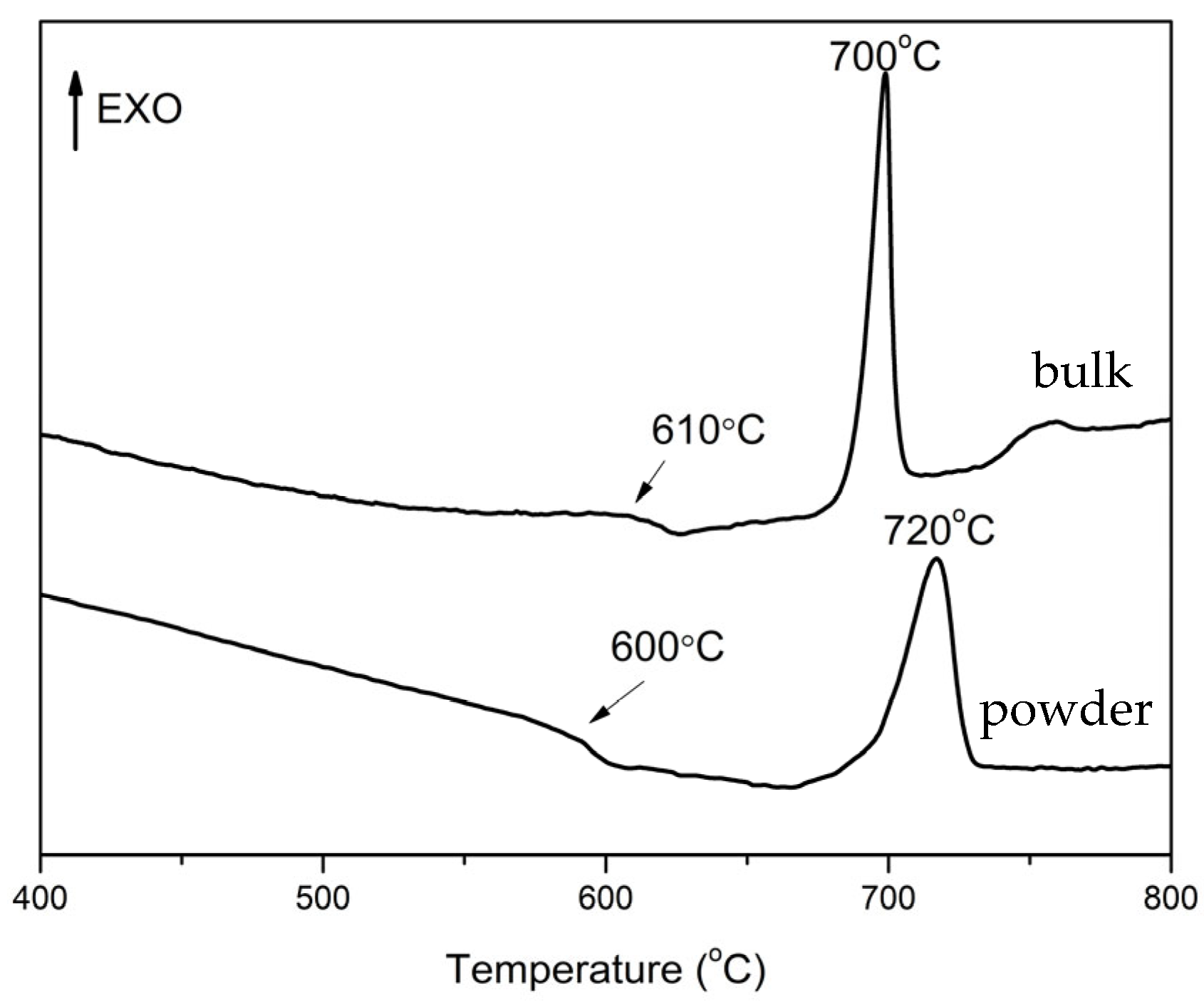
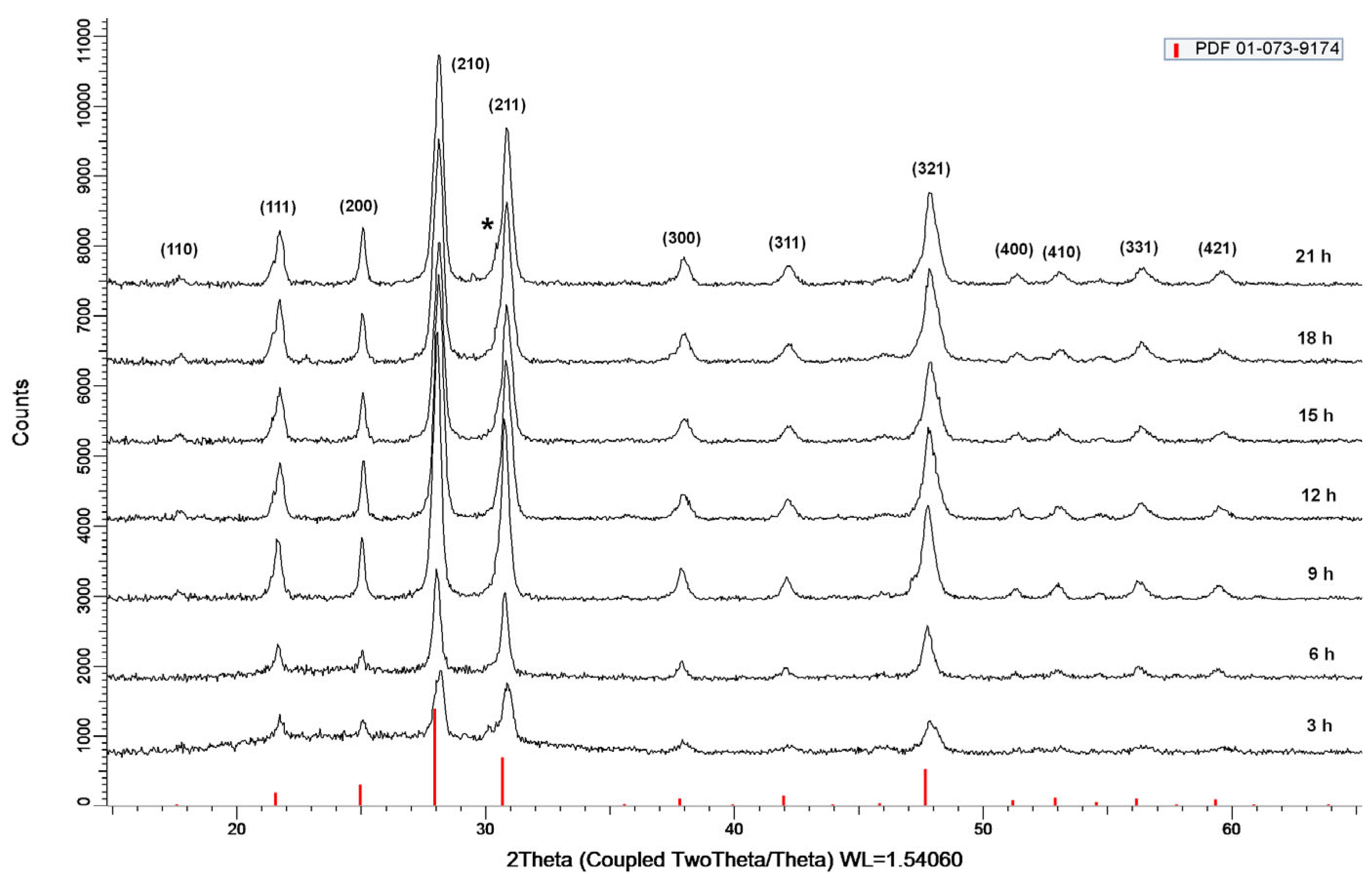
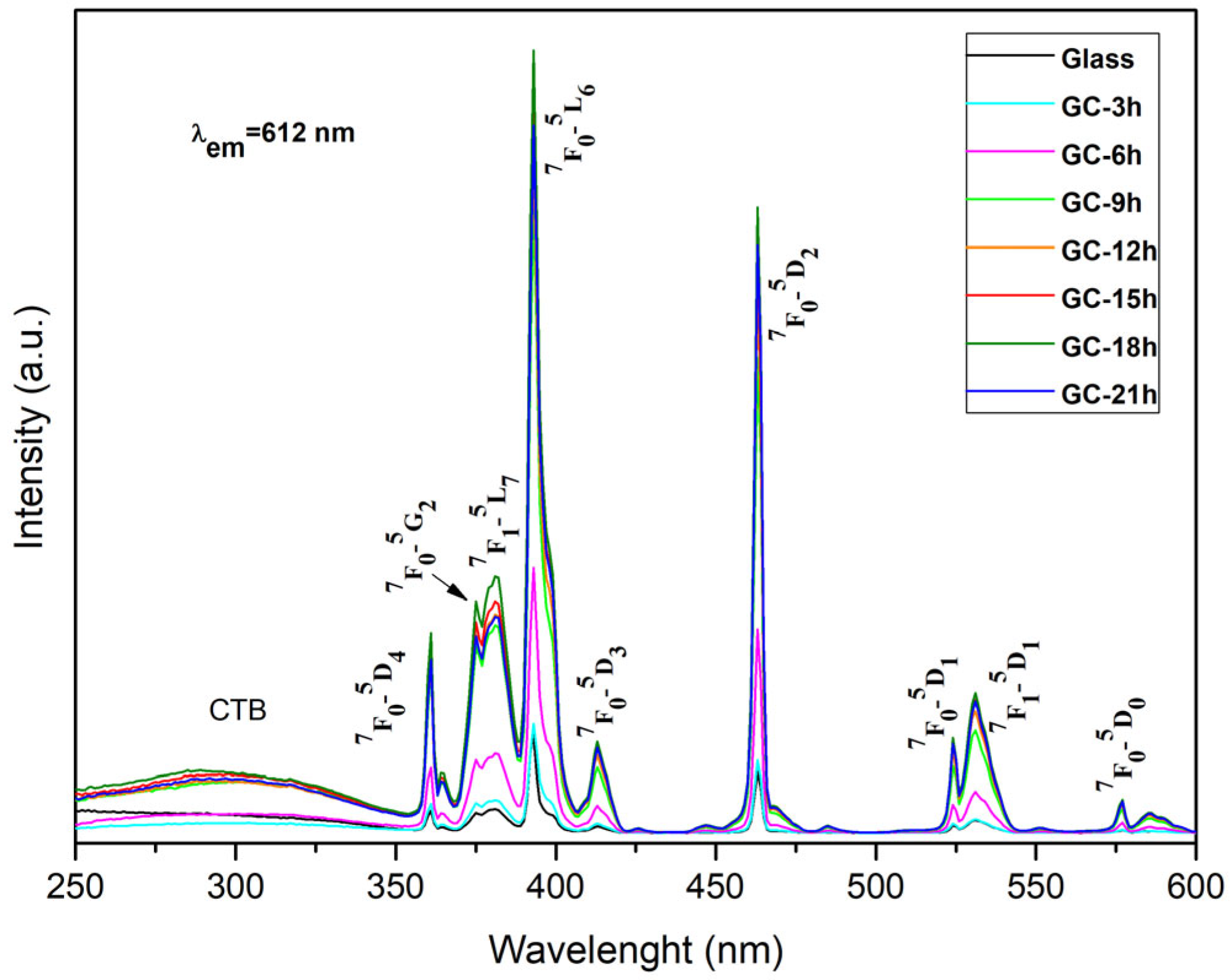
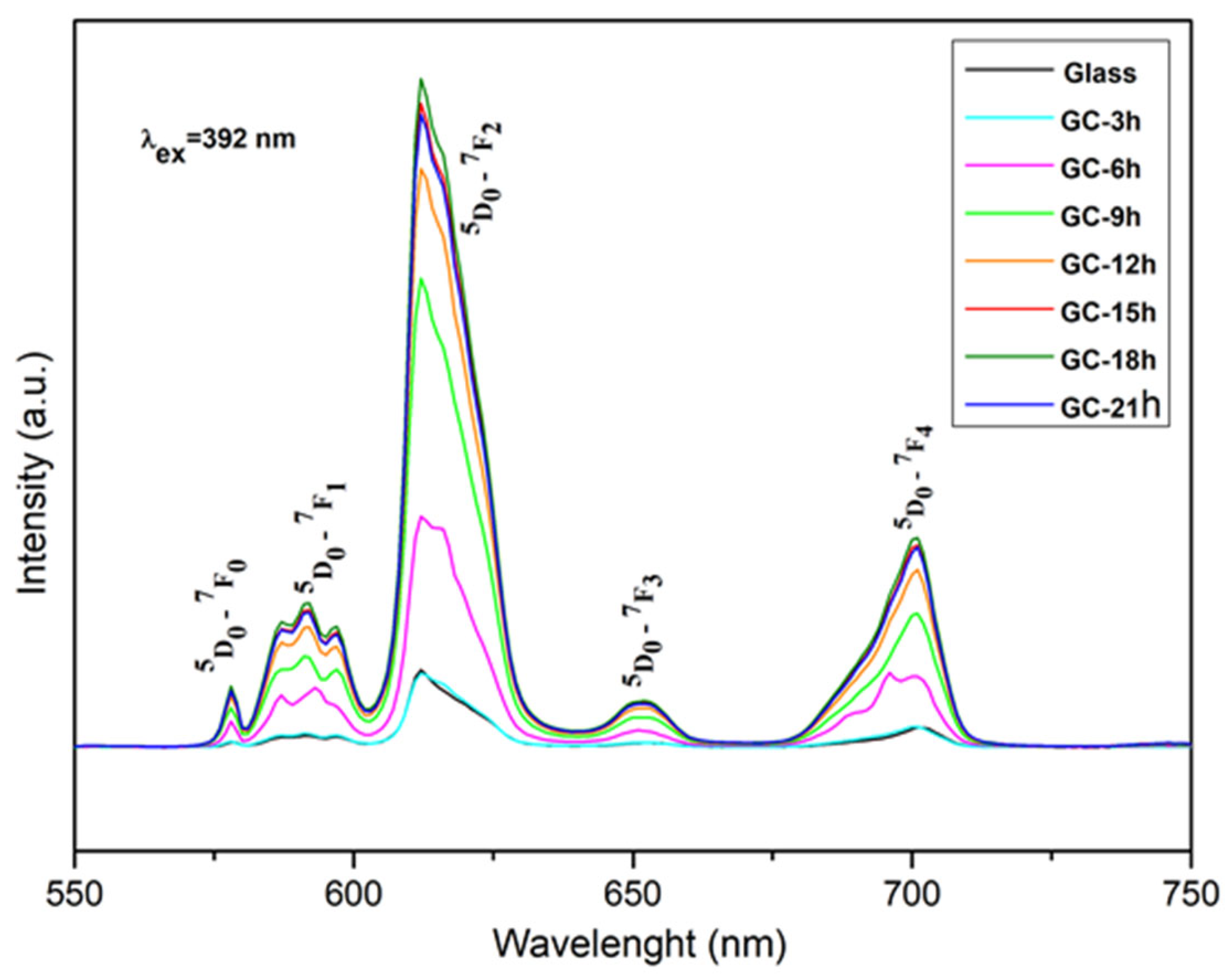


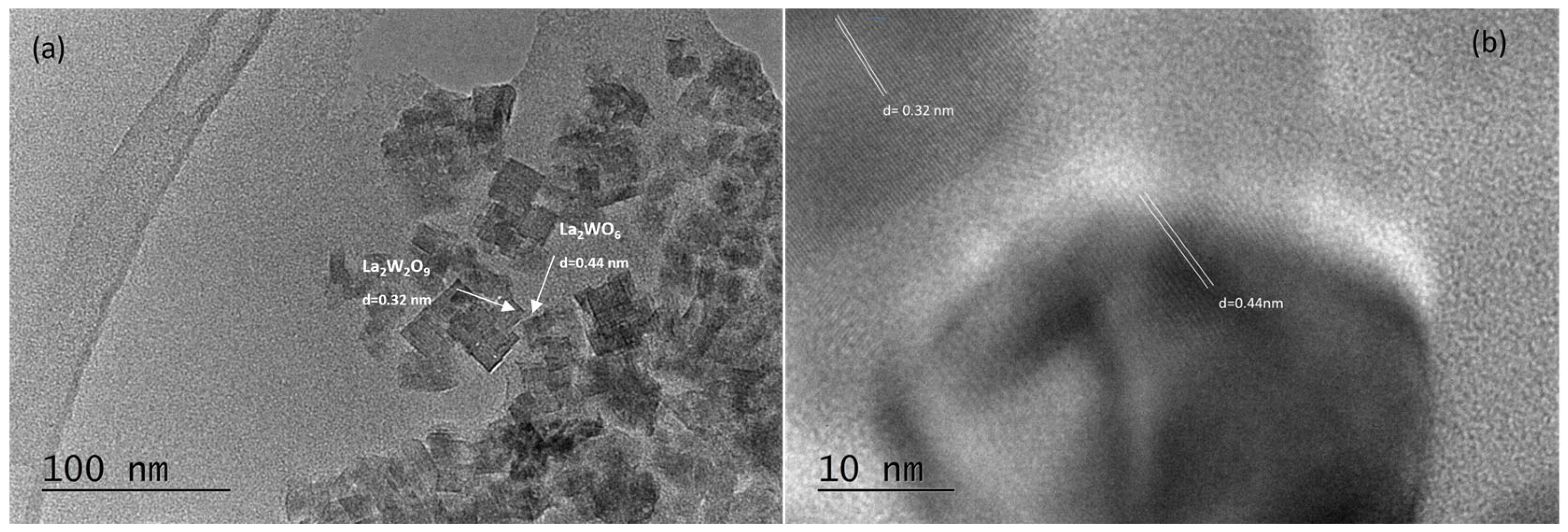
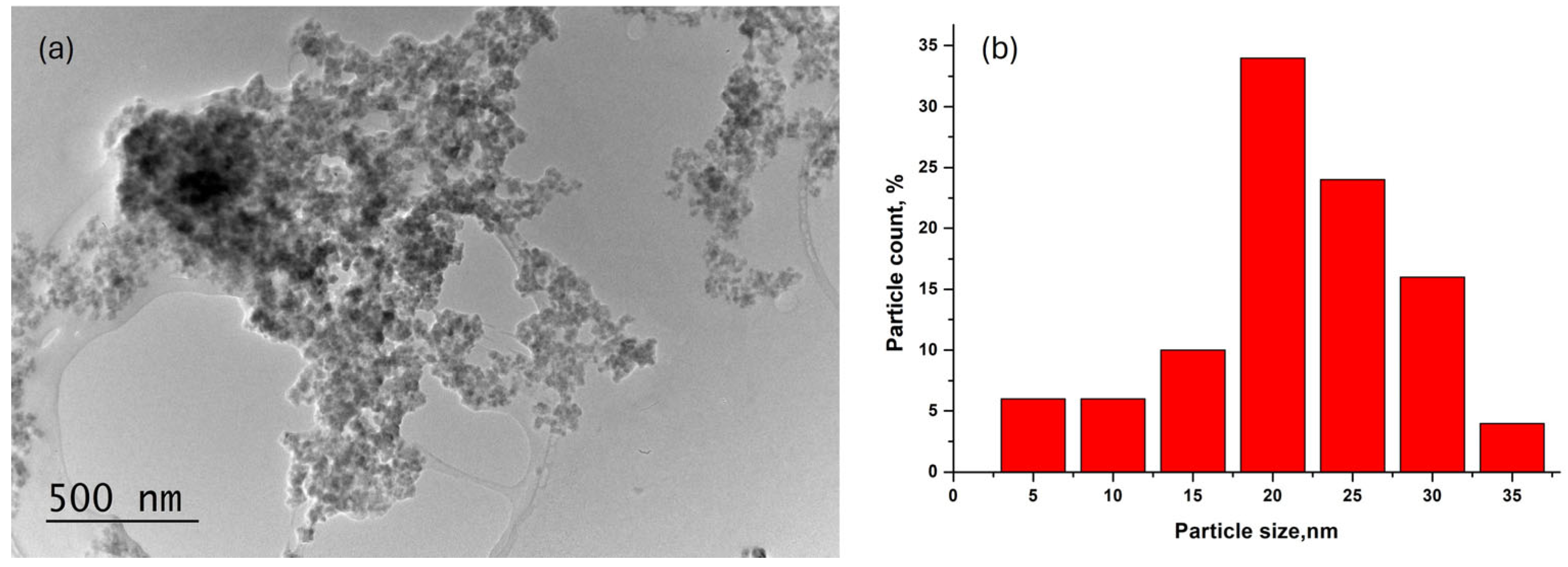
| Crystallized at 680 °C | Unit Cell Parameter [Å] | Crystallite Size [nm] |
|---|---|---|
| 3 h | 7.134(1) | 27.8(6) |
| 6 h | 7.118(2) | 17.9(5) |
| 9 h | 7.132(1) | 26.6(4) |
| 12 h | 7.131(1) | 23.9(3) |
| 15 h | 7.1187(2) | 22.1(3) |
| 18 h | 7.117(1) | 22.1(4) |
| 21 h | 7.119(1) | 23.3(4) |
| Glass Composition | Relative Luminescent Intensity Ratio, R | Reference |
|---|---|---|
| Glass 52WO3:22B2O3:26La2O3:0.5Eu2O3 | 4.88 | Current work |
| GC-3 h | 4.93 | Current work |
| GC-6 h | 5.58 | Current work |
| GC-9 h | 5.83 | Current work |
| GC-12 h | 5.88 | Current work |
| GC-15 h | 5.95 | Current work |
| GC-18 h | 6.12 | Current work |
| GC-21 h | 5.92 | Current work |
| Glass 50ZnO:(50-x)B2O3: xNb2O5:0.5Eu2O3:, x = 0, 1, 3 and 5 mol% | 4.31–5.16 | [29] |
| Glass 50ZnO:40B2O3:10WO3:xEu2O3 (0 ≤ x ≤ 10) | 4.54 ÷ 5.77 | [30] |
| Glass 50ZnO:40B2O3:5WO3:5Nb2O5:xEu2O3 (0 ≤ x ≤ 10) | 5.09 ÷ 5.76 | [31] |
| Glass 66P2O5–10.5Al2O3–3.05BaO–16.5K2CO3–0.7NaF–xEu2O3–0.5Nd2O3–(2.75-x) La2O3 (mol.%), where x = 0, 0.25, 0.5, 0.75, 1.5 and 2 | 3.72 | [32] |
| Glass-ceramic 66P2O5–10.5Al2O3–3.05BaO–16.5K2CO3–0.7NaF–xEu2O3–0.5Nd2O3–(2.75-x) La2O3 (mol.%), where x = 0, 0.25, 0.5, 0.75, 1.5 and 2 | 4.72 | |
| Glass 50ZnO:47B2O3:3Nb2O5:0.5Eu2O3 | 5.16 | [33] |
| Glass-ceramic 50ZnO:47B2O3:3Nb2O5:0.5Eu2O3 | 5.21–5.49 | |
| Glass 74.0 TeO2+25.0 Li2CO3+1.0 Eu2O3 | 3.70 | [34] |
| Glass-ceramic 74.0 TeO2+25.0 Li2CO3+1.0 Eu2O3 | 3.65 | |
| Glass 50Li2O·45B2O3·5Al2O3: 2Eu2O3 | 3.91 | [35] |
| Glass ceramic 50Li2O·45B2O3·5Al2O3: 2Eu2O3 | 4.047 | |
| Glass 7SiO2-47.4CaO-40.5Al2O3-4.1MgO-1Eu2O3 | 4.58 | [36] |
| Glass-ceramic 7SiO2-47.4CaO-40.5Al2O3-4.1MgO-1Eu2O3 | 1.97 |
| Glass Composition | Chromaticity Coordinates (x, y) |
|---|---|
| Glass 52WO3:22B2O3:26La2O3:0.5Eu2O3 | 0.629, 0.328 |
| GC-3 h | 0.650, 0.343 |
| GC-6 h | 0.648, 0.345 |
| GC-9 h | 0.651, 0.345 |
| GC-12 h | 0.651, 0.345 |
| GC-15 h | 0.650, 0.346 |
| GC-18 h | 0.650, 0.346 |
| GC-21 h | 0.651, 0,346 |
| NTSC standard for red light | 0.670, 0.330 |
| Y2O2S:Eu3+ | 0.658, 0.340 |
Disclaimer/Publisher’s Note: The statements, opinions and data contained in all publications are solely those of the individual author(s) and contributor(s) and not of MDPI and/or the editor(s). MDPI and/or the editor(s) disclaim responsibility for any injury to people or property resulting from any ideas, methods, instructions or products referred to in the content. |
© 2025 by the authors. Licensee MDPI, Basel, Switzerland. This article is an open access article distributed under the terms and conditions of the Creative Commons Attribution (CC BY) license (https://creativecommons.org/licenses/by/4.0/).
Share and Cite
Yordanova, A.; Milanova, M.; Aleksandrov, L.; Iordanova, R.; Tzvetkov, P.; Markov, P.; Petrova, P. Preparation of Glass-Ceramic Materials by Controlled Crystallization of Eu2O3-Doped WO3-B2O3-La2O3 Glasses and Their Luminescent Properties. Molecules 2025, 30, 832. https://doi.org/10.3390/molecules30040832
Yordanova A, Milanova M, Aleksandrov L, Iordanova R, Tzvetkov P, Markov P, Petrova P. Preparation of Glass-Ceramic Materials by Controlled Crystallization of Eu2O3-Doped WO3-B2O3-La2O3 Glasses and Their Luminescent Properties. Molecules. 2025; 30(4):832. https://doi.org/10.3390/molecules30040832
Chicago/Turabian StyleYordanova, Aneliya, Margarita Milanova, Lyubomir Aleksandrov, Reni Iordanova, Peter Tzvetkov, Pavel Markov, and Petia Petrova. 2025. "Preparation of Glass-Ceramic Materials by Controlled Crystallization of Eu2O3-Doped WO3-B2O3-La2O3 Glasses and Their Luminescent Properties" Molecules 30, no. 4: 832. https://doi.org/10.3390/molecules30040832
APA StyleYordanova, A., Milanova, M., Aleksandrov, L., Iordanova, R., Tzvetkov, P., Markov, P., & Petrova, P. (2025). Preparation of Glass-Ceramic Materials by Controlled Crystallization of Eu2O3-Doped WO3-B2O3-La2O3 Glasses and Their Luminescent Properties. Molecules, 30(4), 832. https://doi.org/10.3390/molecules30040832





